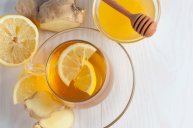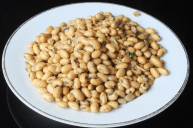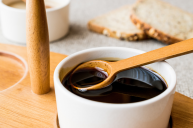When you feel a migraine coming on, a common routine might be to draw the shades, lay down and take an Ibuprofen, Advil or Tylenol to help ease the pain. Let's face it, migraine headaches can be debilitating- from head throbbing and pounding to nausea, sometimes it seems like there's no cure. Over-the-counter migraine medication, like ones with acetaminophen often isn't effective as acute treatment, physical activity makes it worse, and other cures like acupuncture don't work for everyone. Although antidepressants can affect the level of serotonin in your brain, curing migraines, they often have negative side effects. Because of this, eating foods that help migraines is sometimes the best way to go.
Migraine Causes and Symptoms

Some people have a family history of migraines, while others get menstrual, chronic, episodic, menopause or even hemiplegic migraines. No matter what types of migraines you suffer from, the symptoms are often the same.
The American Migraine Foundation lists the common symptoms of migraine as severe headache pain, sometimes on one side of the head and pulsating, ocular or visual disturbances, a migraine aura, nausea and vomiting, and sensitivity to light and sound.
Common risk factors for this painful headache disorder are exposure to loud noises, strong smells, flashing lights, and getting poor sleep. Along with this, acute migraine medication overuse, hormonal changes due to the menstrual cycle, and various underlying medical conditions can cause these debilitating types of headache.
A Tasty Solution!
However, there's good news! Researchers have found that there are plenty of specific foods to help prevent migraines- you probably have most of them in your kitchen right now. Some who suffer from migraines may unknowingly be eating migraine food triggers like cured meats, dairy products, diet soda, citrus fruits, aged cheese with tyramine, food that contains the additive monosodium glutamate (MSG), red wine and alcoholic beverages. Fortunately, we also have a list of the best foods to reach for next time you feel a migraine headache coming on.
1. Dark Leafy Greens
https://www.instagram.com/p/BhrdKuiFOi9/?tagged=spinach
Hey, now you know why your mother told you to eat your greens! Not only are they high in vitamin b2 and b6, iron, as well as many other things, they're one of the best foods for migraine management. Vitamin b2 (riboflavin) rich foods in particular are known to help reduce the intensity and duration of acute migraine headaches, along with being great migraine prevention. While supplements of B vitamins are a good idea, nothing is better than eating them naturally!
So, load up on dark greens like spinach, kale, beet greens, arugula and throw them in a salad or your next smoothie! The lifestyle change of eating more greens will improve your overall health as well!
2. Potatoes
Dehydration is known to cause headaches and migraines, and potatoes are about 75% water, so they can definitely help prevent migraines. Potato juice is a good source of vitamin c, vitamin b1, and potassium. Potassium can help soothe throbbing head pain and sensitivity to bright lights, providing some relief.
Healthcare involves more than just medicine; try using a natural, healthy food instead! Sweet potatoes are also rich in nutrients and be beneficial when you have a migraine attack. Try baking a potato or sweet potato and you might just feel the results.
3. Ginger
If you're a migraine sufferer, try adding this superfood to your diet to help prevent migraines. Ginger can give pain relief as well as relief for nausea and vomiting since those are two common migraine symptoms. You can buy ginger tablets, liquid ginger extract, ginger chewing gum, or just add in some ginger root to your smoothie to help cure migraine pain.
4. Cucumbers
Known for their high water content (about 97%), cucumbers are one of the best foods for a chronic migraine. Slice up a few of these super hydrating veggies to help you stay migraine-free.
5. Nuts and Seeds
Magnesium, which is found in almonds, Brazil nuts, sunflower seeds, sesame seeds, and pumpkin seeds can help prevent blood vessel spasms that could possibly trigger migraines.
One dietary change you can make is to reach for a handful or two your favorite nuts or seeds if you're a migraine sufferer. They make a great midday snack, or you could sprinkle some sesame seeds or sunflower seeds over your favorite salad at lunch.
6. Cold-Water Fish
Cold-water fish such as salmon, tuna, and mackerel are considered to be high in omega 3 fatty acids, which is great for treatment of migraines. Eating fish that is high in omega 3 fatty acids regularly can lead to less headaches. Try cooking your fish in olive oil, which is also shown to reduce the frequency of these painful headaches.
7. Whole Grains
An easy headache cure is to add more whole grains into your diet. Fluctuating blood sugar and blood pressure levels is known to trigger headaches, so make sure to eat plenty of whole grains to stay full longer and to prevent migraines. Brown rice, quinoa, barley, farro, and buckwheat are just a few common foods that help migraines, as they're high in fiber and can help maintain blood sugar levels. They're also delicious.
8. Caffeine
If you're like me and you've become dependent on your daily dose of caffeine, whether it's from a cup of coffee or tea, you might feel a migraine during the day if you miss a dose.
Before it comes on, blood vessels enlarge, which can cause the pain and some researchers think that the caffeine can help relax the blood vessels. However, it's important to drink caffeine in small doses - too much can be a headache trigger on its own.
This post was originally published on June 8, 2018.




